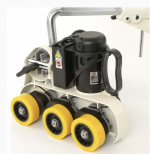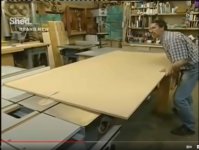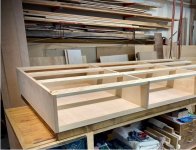Thanks for this feedback.
The Infinity feeder is the same "Baby Feeder" made by "Comatic" in China or Taiwan for many years, sold by Grizzly, Delta, Harbor Freight and others over the years. It's a much loved and much hated tool. It's such a pain to mount that now there's a new $300 magnetic mount for the $400 feeder. Once mounted and adjusted it works well for light duty tasks, like mine. The Baby Feeder is awkward to adjust even once mounted, as it relies on a canted arm and universal joint , so raising and lowering it once it's in position is a several step process, as opposed to turning a single crank, the way it is on all other power feeders, including the Little Proteus.
Three in-line wheels give the Baby Feeder an advantage over mine for some tasks. That disadvantage can be alleviated by mounting both feeder wheels behind the cutter or blade, and using feather boards or other hold downs in front of the blade. Then you feed manually until the work has passed beyond the blade and the feeder takes over. My third wheel on the same shaft at the front gives it a big advantage for band saw use, as you have wheels covering a 6-1/2" height span pushing the work against the fence. For band saw use, mine compares well to the Comatic $900 band saw feeder that works only on band saws, and needs a fairly large band saw table to mount without an extension. The Comatic only supports 3-3/8" height. Mine is about 15 pounds with a drill attached --the Comatic Baby Feeder is like 27 pounds, and their lightweight band saw feeder is 38 pounds. So mine can go on small band saws, lightweight router tables (where the magnetic base won't help you with your Comatic), and mine can go on job site table saws, allowing a single worker with no infeed or outfeed support to rip a 12' board.
Much of the appeal of my unit is the ease of mounting. I have a little video where I mount it on the table saw and feed a board, move it to the router table and feed a board, and then move it to the band saw and feed a board, all in about 2 minutes.
ChuckS, I have thought a lot about trying to get a product based on this mass produced, but that marketing and networking is not at all my area of expertise. I'm a life long craft woodworker (www.alladd.com) and I built the Little Proteus for my own needs, and when I saw how well it worked I decided to try this venture. I know the drill is a real turn-off, but it's a lot of the product's excellence and value. A small gear motor would need an inverter or advanced engineering, and drills are an unbelievable value because of the boggling scale at which they're produced and the years of expert engineering that has gone into their current state of refinement. The high torque at low speed of todays brushless motor drills is the secret behind the Little Proteus working so well on the band saw.
People pay $300 for Jessems table saw hold downs. But my feeder at $360 is a hard sell. It's functionality compared to Jessems hold downs isn't even close. But the aesthetics and "fit and finish" aren't close either. So I resort to posts like this to try to get the word out, and try to overcome people's understandable skepticism. For what it's worth, Fine Woodworking Magazine gave it a thumbs-up:
https://www.finewoodworking.com/2020/12/29/tool-review-little-proteus-power-feeder-from-al-ladd




